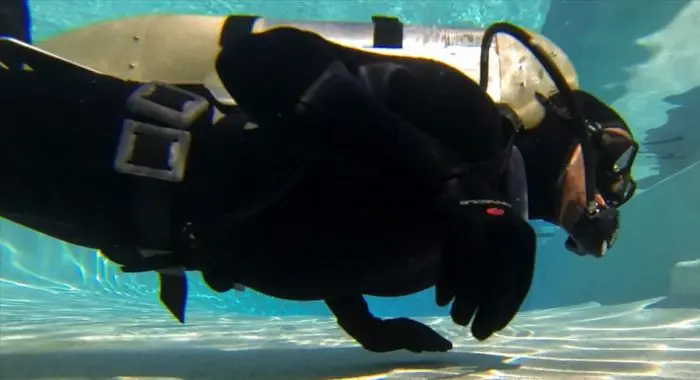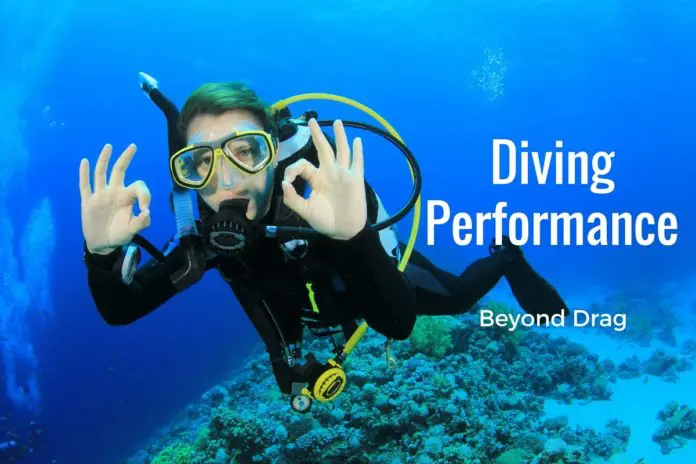In part 1, we identified that ocean conditions are driving swimming speed requirements for divers that are well beyond the speeds that current scuba gear and diving techniques can deliver. Whereas healthy fit divers can achieve sustained speeds of about 1 knot and sprint at about 1.5 knots, the ocean conditions require speeds more along the lines of 3 knots sustained and 5 knots in a sprint. We also noted that while the deviance between required and realized swimming performance is very large, it has become normalized within the diving culture, and as a result, little has been done to rectify the situation.
In Part 2, we were able to show that it is possible for a diver to achieve a sustained cruise speed of 3 knots. We identified that this requirement can be met if we can incorporate a diving fin system that is at least 70% efficient at converting leg energy into net forward thrust and also reduce the diver’s overall drag to less than 22% of the normal drag for a recreational scuba diver. Both of these things are technically possible, but it will require developing gear that streamlines the diver as well as the scuba equipment, and the completed system may look more like the fusiform shape of a cetacean than a 4 limbed person.
Sadly, in part 3 we will not be showing scuba hardware that actually meets the proposed requirement. The technology for this has not been developed yet. Although the underwater orienteering equipment used in CMAS competitions is pretty close in performance, it is far from the equipment utility and versatility required of recreational diving equipment. Instead, we will take a look at some basic technology to move the swimming performance of a recreational scuba diver in the right direction and show how easy it can be to achieve some pretty impressive results without completely changing the look and feel of the traditional recreational scuba kit. Hopefully, these experiments will inspire other divers to take a close look at what they can do to improve their own swimming performance.
My Experiment
I recently conducted an experiment to see how much the performance gap can be closed while keeping the basic equipment layout of a contemporary scuba diver intact. At the heart of this experiment is optimizing the dive fins for swimming efficiency. I made some very efficient fiberglass and plastic composite fins that build on the technology of freediving fins and then take it a step further in evolution for propelling a scuba diver. These are technically stereo-fins as opposed to bi-fins. There are designated right and left fins that are not interchangeable. They fit the foot ergonomically and provide excellent power transfer to the fin without waste energy going into a sloppy and crudely designed foot pocket. The prototypes are called Pilot-SR1 fins, and they are proving to be very effective fins to use for scuba diving. There will be more information on the Pilot-SR1 fins provided in part 4 of “Diving Performance – Beyond Drag”.
Improving the thrust efficiency of the diving fins is critical, but cutting drag is also important, so I didn’t stop with the fins. I also built a prototype recreational scuba rig that incorporates some basic streamlining of the scuba equipment to better conform it to the diver’s body and make it as low drag as possible while keeping the individual parts simple and portable.
I decided to use a single standard aluminum 80 scuba tank for my experiment. High pressure steel tanks are smaller and would be better, but I wanted to see what could be done with the standard tank that I would most likely end up with if I were traveling someplace exotic and remote and rented a tank to go diving. I wanted to keep it simple, only adding a conformal nosecone and a tailcone to the tank. I kept the parts relatively small and light for traveling convenience.
From the beginning, the math told me that this design had no chance of actually meeting my ultimate goal of 3 knots sustained cruise, the speed requirement that I feel should be the standard for diving in the ocean, but I thought it was a worthwhile exercise to build and test this nonetheless. Learn to walk before attempting to run, so to speak. Plus, this technology will feel more familiar to many divers and be more acceptable than something more radical.

The prototype kit consists of a backplate that incorporates an attached nosecone that covers the front end of the tank and conforms to the back of the diver’s head. This closes the gap between the diver’s head and the tank to minimize losses due to flow momentum exchanges in the wake zone between the head and tank. It also makes a comfortable interface for the diver’s head that is much nicer than the first stage regulator that usually makes first contact with the back of the head on a standard scuba kit. I also added a tailcone to the tank to recover some of the tank’s profile drag. The tailcone is large compared to the nosecone, but it is a hollow part that other dive gear can be packed inside of when traveling with dive gear, and the tailcone is still small enough to fit in a scuba gear bag. The kit also has 2 flat side panels that attach to close the interference gap between the diver’s body and the sides of the scuba tank. Being flat, these parts also fit easily into a gear bag.
My initial prototype does not incorporate a BC. For most of the diving I do, it isn’t necessary and I don’t want it. However, incorporating a BC should only require exchanging the side panels for panels that are cut to accommodate a BC mini-wing. I will probably try that at some point when I get my hands on an appropriate mini-wing to use with this kit. I’m hoping I won’t need to make a custom BC.
Achieved Performance
In pool testing, I was able to cruise efficiently at sustainable speeds of about 2 knots. That is double the speeds that are typically sustainable for recreational scuba diving. Without any changes, if a diver that normally had a cruise limit of 1 knot wanted to keep up with me at 2 knots, that diver would have to increase their power output 2 cubed, or by a factor of 8 in order to keep up. This would certainly not be sustainable, if it can even be done at all.
At a speed of 2.5 knots (~2.9 mph), my regulator began to freeflow a lot and I had to limited my speed to prevent a massive waste of my air supply. I’ll need to tweek the regulator to increase its cracking pressure if I want to go faster than this and find out what my actual sprint speed is with this kit. Presently, I expect it will be below 3 knots at max effort.
This kit is efficient enough that traveling at 1 knot is metabolically about equivalent to resting on the bottom and not swimming at all. It can make for some very easy and relaxed diving when in good diving conditions.
Below is a link to a video of swimming with a pod of dolphins. When resting these spinner dolphins orbit the bay at about 2 knots. The video is uncut to illustrate how I have no trouble keeping up with them while maintaining a comfortable breathing rate and workload. The shark is faster, but I could still keep up and follow it. However, I had to limit my pursuit as it was near the end of my dive and the shark was fastly heading away from my exit point.
Diving and swimming with a pod of dolphins
Reef diving with a green sea turtle and a white tip shark
The biggest problem presently is that the kit as shown in the video is fairly tail heavy. When I stop swimming, my feet drop. I’m only wearing the top half of a wetsuit which exaggerates the tail heavy condition of the rig. All the lead I was wearing was up around my head, but there was not much of it to get the total buoyancy right (only 3 pounds). In the future, I will need to work on solutions to get the trim balanced better for floating horizontal. Getting the trim right will make this experimental kit even more streamlined and faster in the water than what is shown in these videos.
Adopting Changes
I hope that my experiment will get scuba divers thinking and talking about swimming performance. The swimming performance of scuba divers is important to the ease and enjoyment of diving and, therefore, the popularity of diving and the health of the diving industry’s economics. It is also important to the in-water safety of scuba divers. What I have done here is easily achieved and there is really no reason that the industry can’t be supporting these types of designs.
Overall these changes are not prohibitively expensive to incorporate in the scope of costs associated with scuba diving. Even in low volume production, the fins that I made could probably be reproduced for prices in the range of $500 to $700. That might sound like a lot compared to traditional mass-produced scuba fins, but it is a small fraction of what most scuba divers will usually spend overall on their gear and their diving. Many scuba divers will spend over $1k on dive computers that do little to expand the capabilities of the diver or improve the comfort of their dives, whereas freedivers have been known to spend over $1k on high performance fins that make a big impact on diving performance. Which large expenditure makes more sense?
Worst case, the nosecone and tailcone for the tank can probably be reproduced for a few hundred dollars each. Low volume and prototype hardware is inherently expensive to make. In high volume production typical of mainstream diving equipment, these prices could get quite a bit better across the board and including the fins. Low volume or high volume manufacturing, either way, this technology will be far less costly and far more practical for recreational diving than getting a $4k to $7k DPV for improving diver speeds.
If enough divers demand diving gear that supports good swimming performance, we can always band together to crowdfund the development of this equipment. Are you onboard?
Through some basic hardware and technique changes, recreational open circuit scuba diving can achieve a significant improvement in diving performance. An efficient cruising speed of about 2 knots can be achieved without changing the basic scuba architecture. It can be done just by reducing drag with some simple fairing elements and using good diving fins and wetsuits. These performance advantages may be experienced by just about any recreational scuba diver and can make dives more fun, relaxing and safe. There is little reason for not making such changes the new normal in recreational scuba diving.
To achieve a sustained cruise speed of 3 knots will require adopting a more radical approach to streamlining and maybe even propulsion. These technologies should still be pursued, but we will get there over time in many steps of incremental developments in diving technology.
In part 4 of “Diving Performance – Beyond Drag”, we will look at some things you can do now to improve your swimming performance in the ocean.

